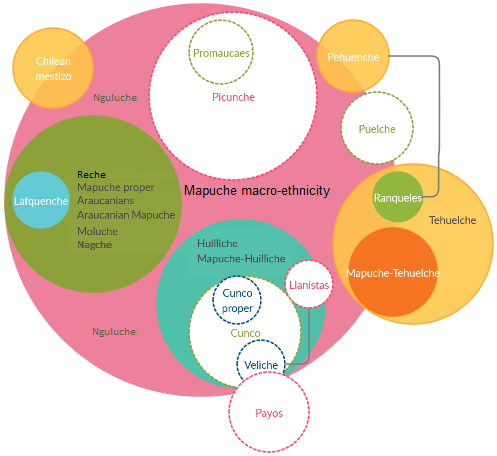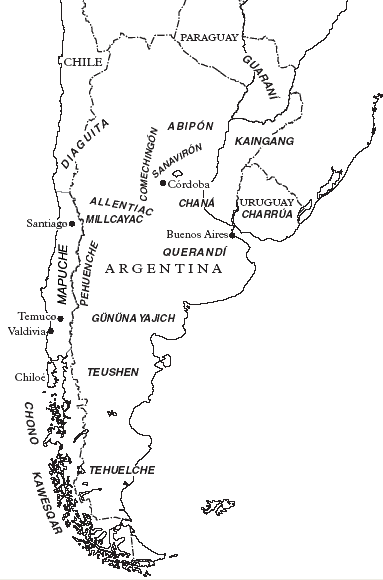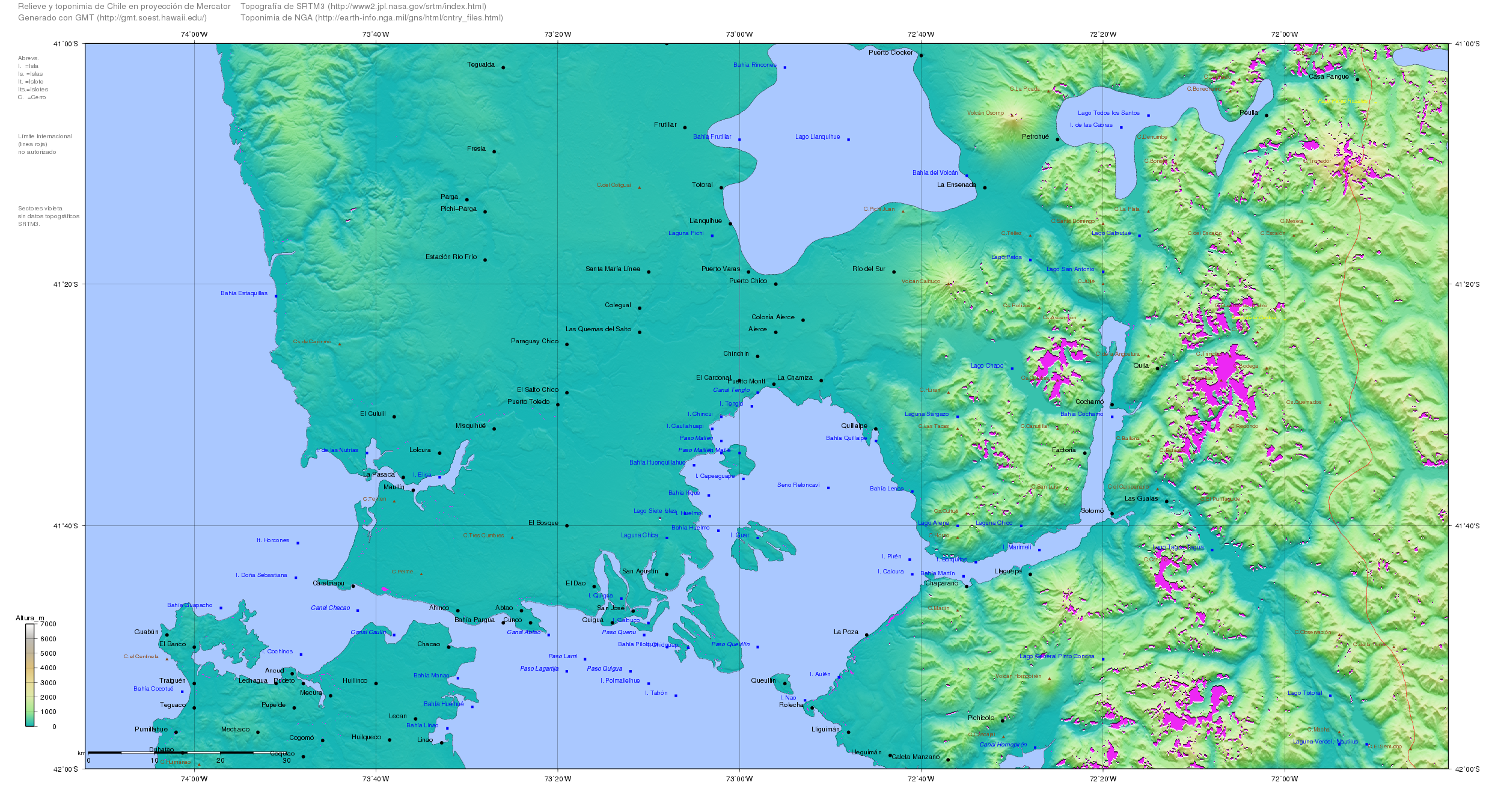|
Mapuche
The Mapuche ( , ) also known as Araucanians are a group of Indigenous peoples of the Americas, Indigenous inhabitants of south-central Chile and southwestern Argentina, including parts of Patagonia. The collective term refers to a wide-ranging ethnicity composed of various groups who share a common social, religious, and economic structure, as well as a common linguistic heritage as Mapudungun speakers. Their homelands once extended from Choapa River, Choapa Valley to the Chiloé Archipelago and later spread eastward to Puelmapu, a land comprising part of the Pampas, Argentine pampa and Patagonia. Today the collective group makes up over 80% of the Indigenous peoples in Chile and about 9% of the total Chilean population. The Mapuche are concentrated in the Araucanía (historic region), Araucanía region. Many have migrated from rural areas to the cities of Santiago and Buenos Aires for economic opportunities, more than 92% of the Mapuches are from Chile. The Mapuche traditional e ... [...More Info...] [...Related Items...] OR: [Wikipedia] [Google] [Baidu] |
Mapuche Religion
Mapuche religion is the traditional Native American religion of the Mapuche people. It is practiced primarily in south-central Chile and southwest Argentina. The tradition has no formal leadership or organizational structure and displays much internal variation. Mapuche theology incorporates a range of deities and spirits. One of the most prominent deities is Ngünechen, sometimes equated with the Christian God. Communal prayer ceremonies are termed ''ngillatun'' and involve the provision of offerings and animal sacrifice. Various different ritual specialists were historically active among the Mapuche, but in the 20th century many of these died out, leaving the ''machi'' as the main kind. These ''machi'' are tasked with overseeing healing and divination, tasks accomplished through their communication with spirits. Historically, the Mapuche were politically independent and prevented conquest by the Incan and Spanish Empires. In 1883 the Chilean military defeated the Mapuche and ... [...More Info...] [...Related Items...] OR: [Wikipedia] [Google] [Baidu] |
Mapuche Language
Mapuche ( , ; from 'land' and 'people', meaning 'the people of the land') or Mapudungun (from 'land' and 'speak, speech', meaning 'the speech of the land'; also spelled Mapuzugun and Mapudungu) is either a language isolate or member of the small Araucanian family related to Huilliche spoken in south-central Chile and west-central Argentina by the Mapuche people. It was formerly known as Araucanian, the name given to the Mapuche by the Spanish; the Mapuche avoid it as a remnant of Spanish colonialism. Mapudungun is not an official language of Chile and Argentina, having received virtually no government support throughout its history. However, since 2013, Mapuche, along with Spanish, has been granted the status of an official language by the local government of Galvarino, one of the many communes of Chile. It is not used as a language of instruction in either country's educational system despite the Chilean government's commitment to provide full access to education in Mapuc ... [...More Info...] [...Related Items...] OR: [Wikipedia] [Google] [Baidu] |
Tehuelche People
The Tehuelche people, also called the Aónikenk, are an Indigenous people from eastern Patagonia in South America. In the 18th and 19th centuries the Tehuelche were influenced by Mapuche people, and many adopted a horseriding lifestyle. Once a nomadic people, the lands of the Tehuelche were colonized in the 19th century by Argentina and Chile, gradually disrupting their traditional economies. The establishment of large sheep farming estates in Patagonia was particularly detrimental to the Tehuelche. Contact with outsiders also brought in infectious diseases ushering deadly epidemics among Tehuelche tribes. Most existing members of the group currently reside in cities and towns of Argentine Patagonia. The name "Tehuelche complex" has been used by researchers in a broad sense to group together Indigenous peoples from Patagonia and the Pampas. Several specialists, missionaries and travelers have proposed grouping them together on account of the similarities in their cultural trai ... [...More Info...] [...Related Items...] OR: [Wikipedia] [Google] [Baidu] |
Chile
Chile, officially the Republic of Chile, is a country in western South America. It is the southernmost country in the world and the closest to Antarctica, stretching along a narrow strip of land between the Andes, Andes Mountains and the Pacific Ocean. Chile had a population of 17.5 million as of the latest census in 2017 and has a territorial area of , sharing borders with Peru to the north, Bolivia to the northeast, Argentina to the east, and the Drake Passage to the south. The country also controls several Pacific islands, including Juan Fernández Islands, Juan Fernández, Isla Salas y Gómez, Desventuradas Islands, Desventuradas, and Easter Island, and claims about of Antarctica as the Chilean Antarctic Territory. The capital and largest city of Chile is Santiago, and the national language is Spanish language, Spanish. Conquest of Chile, Spain conquered and colonized the region in the mid-16th century, replacing Incas in Central Chile, Inca rule; however, they Arauco War ... [...More Info...] [...Related Items...] OR: [Wikipedia] [Google] [Baidu] |
Mapuche Textiles
One of the best-known arts of the Mapuche is their textiles. The tradition of Mapuche textile production dates back to pre-Hispanic times and continues up to this day. Prior to the 20th century Mapuche textiles and ponchos in particular were important trade items. History In Andean societies, textiles had a great importance. They were developed to be used as clothing, as tool and shelter for the home, as well as a status symbol. In the Araucanía region in the sixteenth and seventeenth centuries, as reported by various chroniclers of Chile, the Mapuche worked to have Hispanic clothing and fabrics included as a trophy of war in treaties with the Spanish. They dressed their dead in their best clothes and finest textiles for their funerals. The oldest data on textiles in the southernmost areas of the American continent (southern Chile and Argentina today) are found in some archaeological excavations, such as those of Pitrén Cemetery near the city of Temuco, and the Alboyanco site ... [...More Info...] [...Related Items...] OR: [Wikipedia] [Google] [Baidu] |
Patagonia
Patagonia () is a geographical region that includes parts of Argentina and Chile at the southern end of South America. The region includes the southern section of the Andes mountain chain with lakes, fjords, temperate rainforests, and glaciers in the west and Patagonian Desert, deserts, Plateaus, tablelands, and steppes to the east. Patagonia is bounded by the Pacific Ocean on the west, the Atlantic Ocean to the east, and many bodies of water that connect them, such as the Strait of Magellan, the Beagle Channel, and the Drake Passage to the south. The northern limit of the region is not precisely defined; the Colorado River, Argentina, Colorado and Barrancas River, Barrancas rivers, which run from the Andes to the Atlantic, are commonly considered the northern limit of Argentine Patagonia. The archipelago of Tierra del Fuego is sometimes considered part of Patagonia. Most geographers and historians locate the northern limit of Chilean Patagonia at Huincul Fault, in Araucanía R ... [...More Info...] [...Related Items...] OR: [Wikipedia] [Google] [Baidu] |
Cunco People
Cuncos, Juncos or Cunches is a poorly known subgroup of Huilliche people native to coastal areas of southern Chile and the nearby hinterland. Mostly a historic term, Cuncos are chiefly known for their long-running conflict with the Spanish during the colonial era of Chilean history. Cuncos cultivated maize, potatoes and quinoa and raised chilihueques.Urbina 2009, p. 44. Their economy was complemented by travels during spring and summer to the coast where they gathered shellfish and hunted sea lions. They were said to live in large rukas.Alcamán 1997, p. 32. Cuncos were organized in small local chiefdoms forming a complex system of intermarried families or clans with local allegiance.Alcamán 1997, p. 47. Ethnicity and identity The details of the identity of the Cuncos is not fully clear. José Bengoa defines "Cunco" as a category of Indigenous Mapuche-Huilliche people in southern Chile used by the Spanish in colonial times.Bengoa 2000, p. 122. The Spanish referred ... [...More Info...] [...Related Items...] OR: [Wikipedia] [Google] [Baidu] |
Huilliche
The Huilliche (), Huiliche or Huilliche-Mapuche are the southern partiality of the Mapuche macroethnic group in Chile and Argentina. Located in the Zona Sur, they inhabit both Futahuillimapu ("great land of the south") and, as the Cunco or Veliche subgroup, the northern half of Chiloé Island. The Huilliche are the principal Indigenous people of those regions.Villalobos ''et al''. 1974, p. 49. According to Ricardo E. Latcham the term Huilliche started to be used in Spanish after the second founding of Valdivia in 1645, adopting the usage of the Mapuches of Araucanía for the southern Mapuche tribes. Huilliche means 'southerners' (Mapudungun ''willi'' 'south' and ''che'' 'people'.) A genetic study showed significant affinities between Huilliches and Indigenous peoples east of the Andes, which suggests but does not prove a partial origin in present-day Argentina. During the 16th, 17th, and 18th centuries, the mainland Huilliche were generally successful at resisting Spanish ... [...More Info...] [...Related Items...] OR: [Wikipedia] [Google] [Baidu] |
Indigenous Peoples Of The Americas
In the Americas, Indigenous peoples comprise the two continents' pre-Columbian inhabitants, as well as the ethnic groups that identify with them in the 15th century, as well as the ethnic groups that identify with the pre-Columbian population of the Americas as such. These populations exhibit significant diversity; some Indigenous peoples were historically hunter-gatherers, while others practiced agriculture and aquaculture. Various Indigenous societies developed complex social structures, including pre-contact monumental architecture, organized city, cities, city-states, chiefdoms, state (polity), states, monarchy, kingdoms, republics, confederation, confederacies, and empires. These societies possessed varying levels of knowledge in fields such as Pre-Columbian engineering in the Americas, engineering, Pre-Columbian architecture, architecture, mathematics, astronomy, History of writing, writing, physics, medicine, Pre-Columbian agriculture, agriculture, irrigation, geology, minin ... [...More Info...] [...Related Items...] OR: [Wikipedia] [Google] [Baidu] |
Pehuenche
Pehuenche (or Pewenche) are an Indigenous people of South America. They live in the Andes, primarily in present-day south central Chile and adjacent Argentina. Their name derives from their dependence for food on the seeds of the ''Araucaria araucana'' or monkey-puzzle tree ( in Mapudungun). In the 16th century, the Pehuenche lived in the mountainous territory from approximately 34 degrees to 40 degrees south. Later they became Araucanization, Araucanized and partially merged with the Mapuche peoples. In the 21st century, they still retain some of their ancestral lands. Pehuenche groups participated in various armed conflicts in the 17th and 18th centuries, usually by "descending" from the mountains to the western lowlands of Chile. As such they attacked the Spanish around Maule River Mapuche uprising of 1655, in 1657,Pinochet ''et al''. 1997, p. 82. the Mapuche Mapuche uprising of 1766, in January 1767,Barros Arana, 1886, p. 236. and the Spanish of Isla del Laja on late 1769.Ba ... [...More Info...] [...Related Items...] OR: [Wikipedia] [Google] [Baidu] |
Chiloé Archipelago
The Chiloé Archipelago (, , ) is a group of islands lying off the coast of Chile, in the Los Lagos Region. It is separated from mainland Chile by the Chacao Channel in the north, the Sea of Chiloé in the east and the Gulf of Corcovado in the southeast. All islands except the Desertores Islands form Chiloé Province. The main island is Chiloé Island. Of roughly rectangular shape, the southwestern half of this island is a wilderness of contiguous forests, wetlands and, in some places, Chilean Coast Range, mountains. The landscape of the northeastern sectors of Chiloé Island and the islands to the east is dominated by rolling hills, with a mosaic of pastures, forests and cultivated fields. The archipelago is known within Chile for its distinctive folklore, chilote mythology, mythology, potatoes of Chiloé, potatoes, cuisine of Chiloé, cuisine and unique Chilotan architecture, architecture. The culture of Chiloé is the result of mixing of Huilliche people, Huilliche, Culture of ... [...More Info...] [...Related Items...] OR: [Wikipedia] [Google] [Baidu] |







